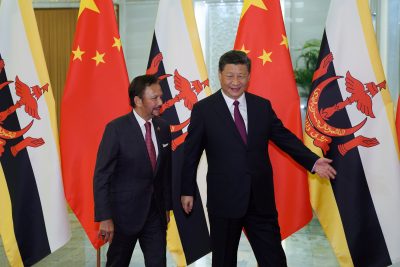China
Making the Belt and Road work for Southeast Asia

Author: Phidel Vineles, RSIS
Southeast Asia is an important strategic partner in China’s Belt and Road Initiative (BRI). The region serves as a key link in the BRI’s Maritime Silk Road, which aims to connect China’s coast to South Asia, the Middle East and Europe through the South China Sea and Indian Ocean. But criticisms of the BRI highlight some of the risks of participation. Southeast Asian countries should address these risks by persuading China to adopt multilateral rules that broaden participation in the BRI, including by leveraging ASEAN’s potential role.
According to a 2018 study by Oxford Economics and the CIMB ASEAN Research Institute, BRI projects in ASEAN countries amount to more than US$739 billion. Indonesia is home to the highest BRI investment total amounting to US$171 billion, followed by Vietnam (US$152 billion), Cambodia (US$104 billion), Malaysia (US$98.5 billion), Singapore (US$70.1 billion), Laos (US$48 billion), Brunei (US$36 billion), Myanmar (US$27.2 billion), Thailand (US$24 billion) and the Philippines (US$9.4 billion).
In April 2019, China hosted the second Belt and Road Forum which was attended by 37 heads of state, government and international organisations. During the Forum, President Xi Jinping said the BRI will adopt multilateral rules and international best practices in implementing the projects.
Xi’s apparent willingness to multilateralise the BRI is necessary to prevent projects in Southeast Asia from being exposed to operational risks, policy risks and project cancellations and to address criticisms of its lack of transparency and inclusivity.
In Laos, for example, locals complain that the labour force on the 414-kilometre BRI railway project, which will link its capital Vientiane to the China-Laos border, is mainly provided by Chinese nationals. This echoes the criticisms of BRI in some other countries which have similar complaints.
The promised BRI Debt Sustainability Framework is laudable for aiming to help allay growing concerns that the BRI is exposing its stakeholders to debt traps. In 2018, Myanmar’s Planning and Finance Minister, Soe Win, wanted to ‘lean’ down a China-led special economic zone project in Kyaukpyu, which was estimated to be worth US$10 billion.
China is also establishing a panel of international mediators from BRI countries to resolve cross-border disputes arising from BRI projects. This initiative is important, since a wide range of contracts and deals are already in place between China and ASEAN member states.
If President Xi is willing to multilateralise the BRI, some ASEAN countries have the opportunity to play important roles in improving the provision of mutual benefits.
Singapore has the potential to be a financial and third-country partnership hub within the BRI. According to Enterprise Singapore, 60 per cent of project finance transactions across ASEAN are led by Singapore-based banks. Moreover, Singapore is well regarded for its transparent business dealings and for being one of the largest offshore Renminbi centres. This puts it in an ideal position for Renminbi trade and investment-related flows. Some local banks have also signed MOUs with Chinese banks to cooperate in cross-border financing.
Some Singaporean firms are already proactive in BRI projects in other ASEAN countries. For example, Surbana Jurong is involved in master-planning for the Kyaukpyu Special Economic Zone and Port in Myanmar. Meanwhile, BRI Connect serves as a platform to facilitate communication within and between BRI projects and to promote Singapore as a regional infrastructure and financial hub. The platform is building a business community around the BRI into which Singaporean firms can tap as partners for BRI projects.
Singapore can also be a dispute resolution hub. In January this year, Singapore and China inked an agreement to establish an international panel of mediators to handle disputes that might arise from the multi-billion-dollar BRI projects. The agreement was signed between the Singapore International Mediation Centre and the China Council for the Promotion of International Trade.
Malaysia too plays an important role in helping the BRI achieve its goal of building a ‘community of common destiny’. This was demonstrated when Malaysia successfully renegotiated the controversial East Coast Rail Link (ECRL), reducing the project’s price tag by about a third. Under the new agreement signed in April between Malaysia and China, the 640-kilometre and 20-station ECRL will cost US$16.7 million per kilometre, compared with US$23.2 million…
Business
China Dismantles Prominent Uyghur Business Landmark in Xinjiang – Shia Waves

The Chinese government demolished the Rebiya Kadeer Trade Center in Xinjiang, affecting Uyghur culture and commerce, prompting criticism from activists amid concerns over cultural erasure and human rights violations.
Demolition of a Cultural Landmark
The Chinese government recently demolished the Rebiya Kadeer Trade Center in Urumqi, Xinjiang, a vital hub for Uyghur culture and commerce, as reported by VOA. This center, once inhabited by more than 800 predominantly Uyghur-owned businesses, has been deserted since 2009. Authorities forcibly ordered local business owners to vacate the premises before proceeding with the demolition, which took place without any public notice.
Condemnation from Activists
Uyghur rights activists have condemned this demolition, perceiving it as part of China’s broader strategy to undermine Uyghur identity and heritage. The event has sparked heightened international concern regarding China’s policies in Xinjiang, which have been characterized by allegations of mass detentions and cultural suppression, prompting claims of crimes against humanity.
Rebiya Kadeer’s Response
Rebiya Kadeer, the center’s namesake and a notable Uyghur rights advocate, criticized the demolition as a deliberate attempt to erase her legacy. Kadeer, who has been living in exile in the U.S. since her release from imprisonment in 2005, continues to advocate for Uyghur rights. She has expressed that her family members have suffered persecution due to her activism, while the Chinese government has yet to comment on the legal ramifications of the demolition.
Source : China Demolishes Uyghur Business Landmark in Xinjiang – Shia Waves
China
China Expands Nationwide Private Pension Scheme After Two-Year Pilot Program

China’s private pension scheme, previously piloted in 36 cities, will roll out nationwide on December 15, 2024, enabling workers to open tax-deferred accounts. The initiative aims to enhance retirement savings, address aging population challenges, and stimulate financial sector growth.
After a two-year pilot program, China has officially expanded its private pension scheme nationwide. Starting December 15, 2024, workers covered by urban employee basic pension insurance or urban-rural resident basic pension insurance across the country can participate in this supplementary pension scheme. This nationwide rollout represents a significant milestone in China’s efforts to build a comprehensive pension system, addressing the challenges of a rapidly aging population.
On December 12, 2024, the Ministry of Human Resources and Social Security, together with four other departments including the Ministry of Finance, the State Taxation Administration, the Financial Regulatory Administration, and the China Securities Regulatory Commission, announced the nationwide implementation of China’s private pension scheme effective December 15, 2024. The initiative extends eligibility to all workers enrolled in urban employee basic pension insurance or urban-rural resident basic pension insurance.
A notable development is the expansion of tax incentives for private pensions, previously limited to pilot cities, to a national scale. Participants can now enjoy these benefits across China, with government agencies collaborating to ensure seamless implementation and to encourage broad participation through these enhanced incentives.
China first introduced its private pension scheme in November 2022 as a pilot program covering 36 cities and regions, including major hubs like Beijing, Shanghai, Guangzhou, Xi’an, and Chengdu. Under the program, individuals were allowed to open tax-deferred private pension accounts, contributing up to RMB 12,000 (approximately $1,654) annually to invest in a range of retirement products such as bank deposits, mutual funds, commercial pension insurance, and wealth management products.
Read more about China’s private pension pilot program launched two years ago: China Officially Launches New Private Pension Scheme – Who Can Take Part?
The nationwide implementation underscores the Chinese government’s commitment to addressing demographic challenges and promoting economic resilience. By providing tax advantages and expanding access, the scheme aims to incentivize long-term savings and foster greater participation in personal retirement planning.
The reform is expected to catalyze growth in China’s financial and insurance sectors while offering individuals a reliable mechanism to enhance their retirement security.
| This article was first published by China Briefing , which is produced by Dezan Shira & Associates. The firm assists foreign investors throughout Asia from offices across the world, including in in China, Hong Kong, Vietnam, Singapore, and India . Readers may write to info@dezshira.com for more support. |
Read the rest of the original article.
China
How a scandal over sanitary pads is shaping feminist activism in China

Chinese sanitary pad brands face scandal over misleading product quality and pH levels. Consumer outrage grows amid larger issues of women’s health neglect and activism for better standards linked to declining fertility rates.
A string of prominent sanitary pad brands in China have become embroiled in a scandal about the quality of their products. The controversy began in early November when consumers complained that that the advertised lengths of many sanitary pads were misleading.
Then, a few days later, customers discovered that many pads had pH levels similar to textiles such as curtains and tablecloths that do not come into frequent contact with skin, potentially causing irritation or harm to users.
The anger only intensified when ABC, one of the companies at the centre of the controversy, responded dismissively to concerned consumers. ABC emphasised that it was complying with national standards, and reportedly replied to a complaint with: “If you cannot accept it, then you can choose not to buy it”.
Chinese companies have since apologised for their sub-par products, and ABC has even said that it was “deeply sorry” for its “inappropriate” response. But for many women in China, this scandal is about more than just defective products. It is part of a troubling pattern in which women’s health and dignity is blatantly disregarded.
In 2022, Chinese women took to social media to advocate for sanitary pads to be sold on trains. Their demands were swiftly dismissed, with China Railway saying sanitary pads were “private items” that women should prepare for themselves in advance.
Some people on the internet echoed this sentiment, arguing that it was inappropriate and unhygienic to sell sanitary pads on trains. “You don’t want sanitary pads sold alongside food, do you?”, one wrote.
Remarks like this laid bare not only the stigma surrounding menstrual blood in China, where it is seen as polluting and shameful, but also the widespread ignorance among men about menstruation. This was again highlighted by one social media user who questioned absurdly: “Why can’t women just hold it in?” The recent scandal over poor quality sanitary pads is yet another chapter in this story.
The neglect of women’s basic needs in China has worsened with the government’s push for higher birth rates. China’s ruling Communist party began actively promoting higher birth rates in the mid-2010s after decades of limiting most families to one child. The push is driven primarily by the state’s concerns over an ageing population and a shrinking labour force.
This pro-natalist agenda, which has been bolstered by media campaigns urging women to prioritise marriage and motherhood, has pressured many to sacrifice their education and careers. In anticipation of having to provide paid maternity leave, employers also often discriminate in the processes of hiring and promotions.
Meanwhile, feminist advocacy faces censorship and suppression. This has included the shutdown of influential media platforms like Feminist Voices and the blocking of #MeToo-related hashtags. Activists have resorted to creative methods, such as using symbols like the “Rice Bunny” (a term that is pronounced “mi tu” in Chinese) emoji, to navigate strict surveillance and content filtering that targets discussions on gender equality.
Why the #RiceBunny hashtag has become China’s #MeToo.
Fighting for change
Women in China are now rallying for higher standards in the production and regulation of sanitary products. They are actively submitting comments via the government’s online platform for the public to provide feedback to standard setting officials.
On November 22, a representative from the organisation responsible for drafting the new standards stated that public feedback had been heard and will be considered in the process. However, this response is far from satisfactory. The same companies that produce sanitary pads in China are heavily involved in setting these standards.
Women’s active involvement in shaping the revision of national standards is reflective of a consistent strategy in which they use government-provided channels for political participation. Yet women in China have now also started to link the issue of low-quality sanitary products to broader societal challenges, including falling fertility rates.
In the 1970s, when China first implemented its one-child policy, over six children were born for every woman of childbearing age. This had dropped to an average of one-and-a-half by the 2000s. At the same time, there is a growing prevalence of infertility in China. A 2021 study published in The Lancet, a peer-reviewed medical journal, shows that China’s infertility rate rose from 12% in 2007 to 18% in 2020. One in every 5.6 Chinese couples of childbearing age faces challenges in conceiving a baby.
Throughout the recent sanitary pad scandal, hashtags such as #LowQualitySanitaryPadsCauseFemaleIntertility have spread across Chinese social media platforms such as Weibo. By aligning their grievances with national anxieties, feminist activists in China are strategically reframing their demands to align with state priorities.
Such an approach may, on the one hand, risk unintentionally reinforcing existing stereotypes about women and societal expectations. But it may also increase the likelihood of their concerns being addressed, as it presents better sanitary product standards as a critical public health and national concern rather than a “women’s issue” that can simply be dismissed.
Feminist activism in China looks to be growing in maturity. Narratives and strategies are now being carefully crafted to ensure maximum impact both in public and policy arenas.
This article is republished from The Conversation under a Creative Commons license. Read the original article.






